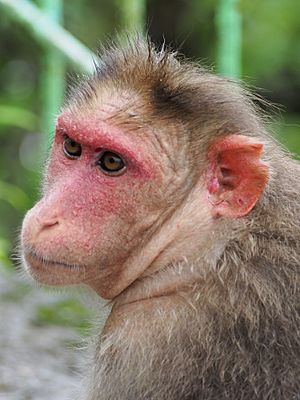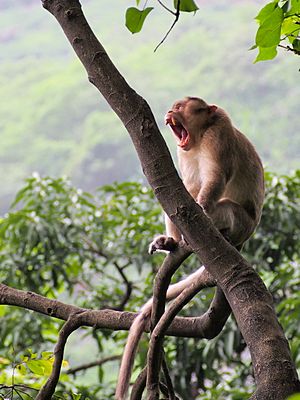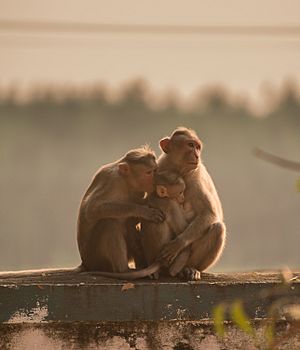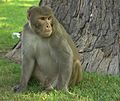Rhesus macaque facts for kids
Quick facts for kids Rhesus macaque |
|
|---|---|
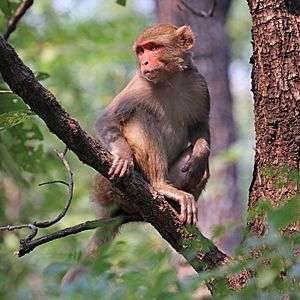 |
|
| Rhesus macaque in Satpura National Park | |
| Conservation status | |
| Scientific classification | |
| Genus: |
Macaca
|
| Species: |
mulatta
|
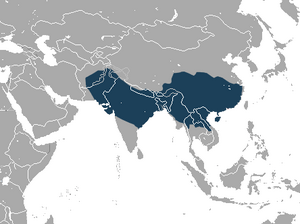 |
|
| Rhesus macaque native range | |
| Synonyms | |
|
Species synonymy
|
|
The rhesus macaque (Macaca mulatta) is a very well-known type of Old World monkey. It's listed as 'Least Concern' on the IUCN Red List, which means it's not currently in danger of disappearing. This is because there are many of them, they live in many different places, and they can adapt to various environments.
They live naturally in South Asia, Central Asia, and Southeast Asia. They have the widest natural range of any non-human primate. You can find them in many different places, from grasslands to forests, and even near human towns.
Contents
What Rhesus Macaques Look Like

Rhesus macaques are usually brown or grey. They have a pink face with no fur. Their tail is about 20.7 to 22.9 centimeters (8 to 9 inches) long.
Adult male macaques are about 53 cm (21 in) long and weigh around 7.7 kg (17 lb). Females are smaller, about 47 cm (18.5 in) long and weighing about 5.3 kg (11.7 lb).
Where Rhesus Macaques Live
Rhesus macaques are found in many countries. These include India, Bangladesh, Pakistan, Nepal, Myanmar, Thailand, Afghanistan, Vietnam, and southern China. They live in many different types of places, from dry, open areas to grasslands, woodlands, and mountains up to 2,500 meters (8,200 feet) high.
These monkeys are good swimmers. Even baby macaques can swim when they are just a few days old. Adults have been seen swimming over half a mile between islands.
Rhesus macaques often move from rural areas to cities. They learn to rely on food given by humans or from human trash. They get along well with people and form larger groups in places where humans live than in forests.
In some parts of India, rhesus macaques live near bonnet macaques. Sometimes, you can even see mixed groups of both species. The rhesus macaque population is growing and spreading. This can be a problem for the bonnet macaques, whose numbers are decreasing in southern India.
In Thailand, the rhesus macaque population is considered endangered in some local areas.
Different Types of Rhesus Macaques
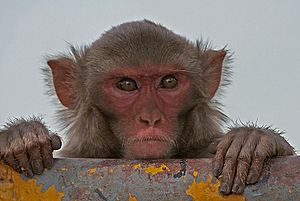
The name "rhesus" comes from a mythological king named Rhesus of Thrace. However, the scientist who named them, Jean-Baptiste Audebert, said the name "has no meaning."
The first description of the rhesus macaque in 1780 said they lived in eastern Afghanistan, Bangladesh, Bhutan, parts of India, Nepal, and northern Pakistan. This group is now called the Indian rhesus macaque (M. m. mulatta). Scientists have also described other types, or subspecies, of rhesus macaques in China. However, the differences between these groups are not always clear enough to call them separate subspecies.
How Rhesus Macaques Live

Rhesus macaques are active during the day. They spend time both in trees and on the ground. They walk on all four limbs.
They mainly eat plants, like fruit, seeds, roots, and bark. They eat about 99 different kinds of plants. During the rainy season, they get a lot of water from juicy fruits. If they are far from water, they lick dew from leaves or drink rainwater from tree hollows. They also sometimes eat termites, grasshoppers, ants, and beetles.
Rhesus macaques have special cheek pouches. They can store food in these pouches to eat later.
These monkeys are quite smart. They can tell things apart, understand simple rules, and even seem to know what they are thinking. They have shown a type of self-awareness. In 2014, people saw one rhesus monkey help another that had been knocked out by power lines. The helper monkey seemed to perform actions to revive it.
Living in Groups
Rhesus macaques live in groups called troops. These troops can have anywhere from 20 to 200 males and females. There are often more females than males. Both males and females have their own social rankings.
Female macaques usually stay with the group they were born into. They have a strong family hierarchy where a female's rank depends on her mother's rank. Younger females often outrank their older sisters. This might be because younger females are stronger and can have more babies. Mothers seem to prevent older daughters from teaming up against them.
Young male macaques also have a family rank. But when they are about four or five years old, the dominant males in the group make them leave. Adult males then gain their rank based on their age and experience.
In a group, macaques sit in places that show their rank. The most important males and females, along with their babies, stay in the center of the group. These central monkeys decide where the group goes and when they eat. The females in this central group are the most dominant. Monkeys farther from the center are less dominant.
Rhesus macaques can be quite strict in their social behavior. High-ranking monkeys often don't tolerate lower-ranking ones and can be aggressive towards them if they are not family.
How They Communicate
Rhesus macaques use many ways to talk to each other. They use facial expressions, sounds, body positions, and gestures.
- One common facial expression is the "silent bared teeth" face. A lower-ranking monkey shows this to a higher-ranking one.
- A less dominant monkey might also make a "fear grimace" with a scream. This is to calm down a dominant monkey or to stop aggression.
- Another way to show submission is to "present rump." The monkey raises its tail and shows its rear to a dominant monkey.
- A dominant monkey might threaten another by standing on all fours and staring with an "open mouth." Its tail will stick straight up.
- When moving, macaques make soft cooing and grunting sounds.
Rhesus Macaques in Science

The rhesus macaque is very important in science. They are easy to care for in labs, are widely available, and are similar to humans in many ways. Because of this, they have been used a lot in medical and biological research.
- They gave their name to the Rh factor in human blood groups.
- They were used in studies by Harry Harlow about how important a mother's care is for baby monkeys. These studies showed that baby monkeys need comfort and care, not just food, to grow up healthy.
- Rhesus macaques helped develop vaccines for rabies, smallpox, and polio.
- They helped create medicines to manage HIV/AIDS.
- They helped scientists understand the female reproductive cycle and how embryos develop. They also helped with the study of embryonic stem cells.
The U.S. Army, Air Force, and NASA sent rhesus macaques into space in the 1950s and 1960s. The Russian space program also sent them into space until 1997. Albert II was the first primate and mammal in space in 1949. Another rhesus monkey, Able, was one of the first living beings to travel to space and return alive in 1959.
In 1999, a rhesus macaque named Tetra became the first cloned primate. In 2001, ANDi was born. ANDi was the first transgenic primate, meaning it had genes from another animal (a jellyfish).
Most studies on rhesus macaques happen in northern India. But some knowledge comes from a group of monkeys living on Cayo Santiago island near Puerto Rico. There are no predators on the island, and humans are only allowed there for research.
Rhesus macaques, like many macaques, can carry the herpes B virus. This virus usually doesn't harm the monkeys. However, it can be very dangerous to humans if it spreads to them.
Protecting Rhesus Macaques
The rhesus macaque is listed as 'Least Concern' on the IUCN Red List. This means they are not currently at high risk of disappearing. There are many of them, and they can live in many different places, including cities. They have the largest natural range of any non-human primate.
However, in Thailand, their population is locally threatened. Losing their habitat and farms expanding into their areas are problems. Also, when people release pet monkeys of different species into existing groups, it can mix up the monkey's genes. This can put their natural genetic makeup at risk.
Even though we know a lot about how they live, not much attention has been paid to their population numbers. This could be a risk for future rhesus macaque populations. Their spread into new areas, sometimes caused by humans moving them, can also put stress on other monkey species.
Images for kids
See also
 In Spanish: Macaco Rhesus para niños
In Spanish: Macaco Rhesus para niños



